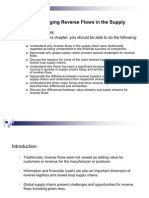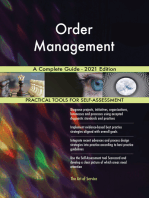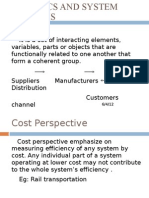Supply Chain Technology
Supply Chain Technology
Uploaded by
josetaqueoCopyright:
Available Formats
Supply Chain Technology
Supply Chain Technology
Uploaded by
josetaqueoCopyright
Available Formats
Share this document
Did you find this document useful?
Is this content inappropriate?
Copyright:
Available Formats
Supply Chain Technology
Supply Chain Technology
Uploaded by
josetaqueoCopyright:
Available Formats
Chapter 6 Supply Chain TechnologyManaging Information Flows
Learning Objectives
After reading this chapter, you should be able to do the following:
Appreciate the overall importance of information to supply chain management. Understand the role of information technology in the supply chain.
Explain the key components of an integrated supply chain information system.
Describe and differentiate between the primary types of supply chain solutions and their capabilities. Discuss the critical issues in technology selection and implementation processes. Recognize the role of emerging technologies for improving supply chain information management.
Information Technology and Supply Chains
Information,
along with materials and money, must readily flow across the supply chain to enable the planning, execution, and evaluation of key functions. participant in the supply chain needs relevant information to make effective forecasts and operational decisions. supply chain information technologies support timely, cost-efficient sharing of information between suppliers, manufacturers, intermediaries, logistics services providers, and customers.
Each
Existing
The Need for Information
information
is the lifeline of business, driving effective decisions and actions. It is especially critical to supply chain managers because their direct line of sight to supply chain processes is very limited. wide variety of information is needed for a supply chain to perform as anticipated.
seven Rs
The
information
must be accessible, relevant, accurate, timely, and transferable
Information must be:
Accessible Relevant Accurate
Timely
Transferable
Figure 6-2 Six Drivers of Supply Chain Excellence
10 Golden Rules for Success
Secure the commitment of senior management.
Remember that it is not just an information technology project. Align the project with business goals.
Follow a proven implementation methodology.
Take a step-by-step approach for incremental value gains.
Be prepared to change business processes.
Keep end users informed and involved. Measure success with key performance indicators (KPIs).
Understand the software capabilities.
Select partners carefully.
Figure 6-4 Master Model of Supply Chain Excellence
Data Collection and Synchronization
Data must be collected and synchronized so that it can be used by skilled individuals in the planning and execution of supply chain processes. Data collection of relevant information is needed at every point in the supply chain. Data synchronization focuses on the timely and accurate updating of item information within and across enterprises. Functional expertise in each organization will be enhanced by access to the synchronized data.
Planning
Execution Supply chain execution tools and suites carry out key tasks from the time an order is placed until it is fulfilled. This orderdriven category of software focuses on the day-to-day activities required to buy, make, and deliver the materials that flow through the supply chain. Event Management Supply chain event management tools collect data in real time from multiple sources across the supply chain and convert them into information that gives business managers a clear picture of how their supply chain is performing.
Enterprise Resource Planning (ERP)
ERP systems are multimodule application software platforms that help organizations manage the important parts of their businesses.
ERP systems branch out to include supplier relationship management, customer relationship management, and other supply chain components, the connections between SCIS and ERP grow stronger. ERP system provides a mechanism for supply chain members to efficiently share information
Figure 6-6 ERP Integration of Supply Chain Technology Capabilities
Source SAP AG
Related Tools
Supply chain collaboration tools help users integrate their information technology systems with those of trading partners to streamline and automate supply chain processes.
Data synchronization applications provide a platform for manufacturers, distributors, and retailers to aggregate and organize item-related data. Spreadsheets and database software provides managers with handy, portable tools for gathering, consolidating, and analyzing supply chain data.
Source: Manhattan Associates, Inc.
Software Options
commercial software
in-house solutions choose between single vendor suites, applications from multiple vendors, consider licensing versus on-demand purchases solutions Packages determine what types of applications are needed and how they should be purchased
Purchase Options
software vendors installed on the buyers powerful client-server systems downside is high capital investment and complex deployment associated with conventional licensed applications Application Service Providers ASP owns and operates the software application and its servers that run the application with access via the Internet.
Data Standardization
Coordinating and sharing information across the supply chain can be a significant challenge. EDI provides interorganizational, computer-to-computer exchange of structured information in a standard, machine-processable format. XML is a robust, logically verifiable text format based on international standards. It provides a flexible way to create structured, common information formats and share both the format and the data via the Internet, intranets, and other networks
Asking the Right Questions
Who will lead our implementation effort? How will technology support our business needs and processes? What is the status of our existing data? How well does our existing system integrate with suppliers and customers? What external issues must our systems address?
Radio-Frequency Identification (RFID)
RFID is an automatic identification method. RFID tags consist of a microchip and a printed antenna that can be packaged into many forms, such as a label, or imbedded in between the cardboard layers in a carton or product packaging. Unique product identification information, in the form of a universal electronic product code (EPC) identifying the manufacturer, product category, and individual item, is stored on these 96-bit tags. RFID technology costs must continue to decline to make product tagging economically feasible; equipment issues such as reader range, sensitivity, and durability must improve; the case for supplier return on investment of RFID mandates must be made; and consumer privacy issues must be resolved.
Adaptive Supply Chain Networks
These integrated, flexible networks of companies, technology tools, and processes focus on customers and their changing requirements. An effective ASCN can respond to changes in real time, allowing the network to prevent or minimize supply chain problems. ASCNs help meet the growing need for supply chain connectivity and collaboration, two key information issues. Connectivity provides visibility.
Summary
In order for supply chain managers to utilize information, it must be readily accessible, relevant to their decision making needs, accurate, timely, and in a format that can be shared. When properly implemented, information technology supports critical supply chain capabilities and strategies, including supply chain connectivity, product visibility, partner collaboration, and process optimization. A well-designed SCIS framework links people, processes, and technology in a manner that provides actionable information and enhances decision making.
Timely data collection and synchronization support supply chain visibility, exception management, and effective response to changing customer requirements.
Summary
Supply chain software falls into four general categories: planning tools for forecasting and related activities, execution systems for management of day-to-day processes, event management tools to monitor supply chain flows, and business intelligence applications that help organizations analyze performance. Given the potential stumbling blocks, software selection and implementation are not a minor undertaking. Needs must be assessed, software options studied, technical issues addressed, and important questions asked before major SCIS investments are made. Change is the norm when it comes to supply chain technologies. It is critical that developments related to RFID and other innovations are understood so that organizations can take full advantage of worthwhile technologies.
You might also like
- Chapter 15 - Managing Reverse Flows in The Supply ChainDocument15 pagesChapter 15 - Managing Reverse Flows in The Supply ChainArman100% (1)
- Assignment 1Document7 pagesAssignment 1Sivaramakrishnan KasiviswanathanNo ratings yet
- Bennet, N. & Lemoine, G. (2014) - What A Difference A Word Makes, Understanding Threats To Perfomance in A VUCA Word.Document7 pagesBennet, N. & Lemoine, G. (2014) - What A Difference A Word Makes, Understanding Threats To Perfomance in A VUCA Word.FranciscoNo ratings yet
- Profiling Political Leaders Cross-Cultural Studies of Personality and BehaviorBy Ofer Feldman, Linda O. Valenty PDFDocument314 pagesProfiling Political Leaders Cross-Cultural Studies of Personality and BehaviorBy Ofer Feldman, Linda O. Valenty PDFAlexandrinasabau100% (2)
- IT in Supply Chain ManagementDocument62 pagesIT in Supply Chain Managementrohitsingh17No ratings yet
- Information Technology in Supply Chain ManagementDocument15 pagesInformation Technology in Supply Chain ManagementSiya Macwan100% (1)
- Strategic Supply Chain Management - Chapter 6Document34 pagesStrategic Supply Chain Management - Chapter 6Enamul Huque SarkerNo ratings yet
- Information System For Supply Chain ManagementDocument18 pagesInformation System For Supply Chain ManagementashishlordNo ratings yet
- SCM Network Design: Loney T BabyDocument10 pagesSCM Network Design: Loney T BabyAnnonymous963258No ratings yet
- Chp1 - Intro To Lgs & SCDocument59 pagesChp1 - Intro To Lgs & SCUK Shukla100% (1)
- Enterprise Resource Planning (ERP)Document24 pagesEnterprise Resource Planning (ERP)Nilmani KumarNo ratings yet
- Ae Aesos Learning Packet No. 1 PrelimDocument31 pagesAe Aesos Learning Packet No. 1 Prelimsean buenaventuraNo ratings yet
- Unit - 1: Supply-Chain Network Design (Edit)Document18 pagesUnit - 1: Supply-Chain Network Design (Edit)aman singhNo ratings yet
- Supply Chain ManagementDocument12 pagesSupply Chain ManagementAKHIL JOSEPHNo ratings yet
- Introduction To Supply Chain ManagementDocument45 pagesIntroduction To Supply Chain ManagementAsha ChikkaputtegowdaNo ratings yet
- Technology in Supply Chain ManagementDocument8 pagesTechnology in Supply Chain ManagementjasmineNo ratings yet
- SCM 0301 - CSDocument26 pagesSCM 0301 - CSGeorges LolcatsNo ratings yet
- Unit 1logistics ManagementDocument13 pagesUnit 1logistics ManagementSidhu boiiNo ratings yet
- Differences Between Logistics and Supply ChainDocument3 pagesDifferences Between Logistics and Supply ChainNikhil BhaskarNo ratings yet
- Chapter 2 Role of Logistics in Supply Chains Learning ObjectivesDocument13 pagesChapter 2 Role of Logistics in Supply Chains Learning ObjectivesAshik AlahiNo ratings yet
- What Is Reverse Logistics - Khuene NagelDocument6 pagesWhat Is Reverse Logistics - Khuene NagelJose HernandezNo ratings yet
- Supply Chain Performance MeasureDocument26 pagesSupply Chain Performance MeasureRohit DuttaNo ratings yet
- An Overview of SCORDocument23 pagesAn Overview of SCORShashank KapoorNo ratings yet
- Basic of Logistics Management - 1553484948 PDFDocument34 pagesBasic of Logistics Management - 1553484948 PDFManoj Kuchipudi100% (1)
- Logistics NotesDocument18 pagesLogistics NotesRadha Raman SharmaNo ratings yet
- Shipping Outside The Box. Environmental Impact and Stakeholder Analysis of A Crowd Logistics Platform in BelgiumDocument11 pagesShipping Outside The Box. Environmental Impact and Stakeholder Analysis of A Crowd Logistics Platform in BelgiumFabian WerleNo ratings yet
- Designing Supply Chain Network: Marilou C. MiculobDocument23 pagesDesigning Supply Chain Network: Marilou C. MiculobMarc Allem Montero PajoNo ratings yet
- Chap 12 Performance Measurement FINALDocument14 pagesChap 12 Performance Measurement FINALOnkar SawantNo ratings yet
- Supply Chain Model PDFDocument6 pagesSupply Chain Model PDFNeha KumarNo ratings yet
- Global Trends in Supply ChainDocument28 pagesGlobal Trends in Supply ChainSaikumar SelaNo ratings yet
- Unit III. Planning Demand and Supply in A Supply ChainDocument32 pagesUnit III. Planning Demand and Supply in A Supply ChainAngel Fe BedoyNo ratings yet
- Lecture 7 Supply Chain Technology - Managing Information FlowsDocument62 pagesLecture 7 Supply Chain Technology - Managing Information FlowsEdward TrầnXDNo ratings yet
- Introduction e CommerceDocument84 pagesIntroduction e CommerceMohd FirdausNo ratings yet
- Introduction To E-Business SystemsDocument19 pagesIntroduction To E-Business SystemsArtur97% (79)
- Lecture 1 - Understanding The Supply ChainDocument27 pagesLecture 1 - Understanding The Supply ChainNhi Nguyễn Thị NgânNo ratings yet
- Supply Chain ManagementDocument5 pagesSupply Chain Management버니 모지코No ratings yet
- Basic Concepts of Supply Chain ManagementDocument42 pagesBasic Concepts of Supply Chain ManagementMarcela BerrocalNo ratings yet
- Supply Chain Management-Historical PerspectiveDocument7 pagesSupply Chain Management-Historical PerspectiveTalha SaeedNo ratings yet
- Case LogisticsDocument14 pagesCase LogisticsMartha PugaNo ratings yet
- The Impact of Adopting "Business Intelligence (BI) " in OrganizationsDocument64 pagesThe Impact of Adopting "Business Intelligence (BI) " in Organizationsmartha_1983No ratings yet
- Importance of Reverse Logistics in Supply Chain ManagementDocument27 pagesImportance of Reverse Logistics in Supply Chain ManagementRenjith SdNo ratings yet
- Chapter 10 - Facility LocationDocument48 pagesChapter 10 - Facility LocationTrey Holton100% (2)
- Case Analysis - Importance of SCMDocument18 pagesCase Analysis - Importance of SCMNikhil AjitNo ratings yet
- Channel Flow, Design and FunctionsDocument19 pagesChannel Flow, Design and FunctionsAvichal MehrotraNo ratings yet
- E-Commerce:: E-Business Is The Use of The Internet and Other Networks andDocument13 pagesE-Commerce:: E-Business Is The Use of The Internet and Other Networks andImroz MahmudNo ratings yet
- 1.4 Different Types of Logistics ManagementDocument21 pages1.4 Different Types of Logistics ManagementLara Camille CelestialNo ratings yet
- Data Warehousing Business Intelligence Syllabus - 1921-T5 PDFDocument7 pagesData Warehousing Business Intelligence Syllabus - 1921-T5 PDFSusmita ChopadekarNo ratings yet
- Retail Management & SCMDocument11 pagesRetail Management & SCMnithinsdnNo ratings yet
- Introduction To Logistics Management Module 4Document19 pagesIntroduction To Logistics Management Module 4Kyle SikorskyNo ratings yet
- CH 07Document23 pagesCH 07Azeeza AsemNo ratings yet
- Why Blockchain in Supply ChainsDocument6 pagesWhy Blockchain in Supply ChainssmitNo ratings yet
- Submitted To: Submitted byDocument18 pagesSubmitted To: Submitted byRohit Patel100% (2)
- Introduction To Logistic ManagementDocument28 pagesIntroduction To Logistic ManagementRosalie RosalesNo ratings yet
- Achieving Value For Money (VFM) in Construction ProjectsDocument11 pagesAchieving Value For Money (VFM) in Construction Projectsolatos4jesusNo ratings yet
- Chapter 1.1 Introduction To Distribution ManagementDocument25 pagesChapter 1.1 Introduction To Distribution Management有川静寂No ratings yet
- Logistics and System AnalysisDocument22 pagesLogistics and System AnalysisAvinash Hacholli0% (2)
- Warehousing in SCMDocument8 pagesWarehousing in SCMbikramNo ratings yet
- Multichannel Retailing.-Mftech - Final PPT - PpsDocument64 pagesMultichannel Retailing.-Mftech - Final PPT - PpsDivyanshJainNo ratings yet
- Distribution LogisticsDocument2 pagesDistribution LogisticsgeethamadhuNo ratings yet
- Chapter 6 - Supply Chain Technology, Managing Information FlowsDocument26 pagesChapter 6 - Supply Chain Technology, Managing Information FlowsArman100% (1)
- Gautham Gopinath: Career ObjectiveDocument2 pagesGautham Gopinath: Career ObjectiveTeam Leader CPMNo ratings yet
- Strategic Management AssignmentDocument5 pagesStrategic Management Assignmentchunkz fever PRCNo ratings yet
- Operations Strategy of Potato Chips CompanyDocument13 pagesOperations Strategy of Potato Chips CompanyMd Redoy Hossain0% (1)
- Organizational ArchetypesDocument7 pagesOrganizational Archetypescaine0001No ratings yet
- Digital Transformation Quick Start S PDFDocument20 pagesDigital Transformation Quick Start S PDFjaykhor9328100% (1)
- Chapter12 ERPDocument9 pagesChapter12 ERPverarvindNo ratings yet
- Assignment 2 (Individual Submission) : Insert Individual Picture HereDocument8 pagesAssignment 2 (Individual Submission) : Insert Individual Picture HerePhoebe ShalinyNo ratings yet
- IPDC 2 Question Bank (2021)Document22 pagesIPDC 2 Question Bank (2021)It's Patel100% (1)
- Deborah Schroeder Saulnier Employee EngagementDocument6 pagesDeborah Schroeder Saulnier Employee EngagementsoortyNo ratings yet
- CPM Study Guide(完全版M1,M2,M3,M4模块,适合CPM及CPSM学习使用)Document507 pagesCPM Study Guide(完全版M1,M2,M3,M4模块,适合CPM及CPSM学习使用)Louie_19790% (1)
- Mckinsey 7S Framework: Strategic Management Tom Peters, Robert Waterman, Julien PhilipsDocument11 pagesMckinsey 7S Framework: Strategic Management Tom Peters, Robert Waterman, Julien Philipssonal jain100% (1)
- Innovation StrategyDocument12 pagesInnovation StrategyGourav Guha0% (1)
- CVAC MultidisciplinaryDocument14 pagesCVAC Multidisciplinaryksucheta013No ratings yet
- Localisation Through Transformative Partnerships - Localisation Learning BriefDocument11 pagesLocalisation Through Transformative Partnerships - Localisation Learning BriefHendra WijayaNo ratings yet
- Laura Landon InterviewDocument6 pagesLaura Landon Interviewapi-302069672No ratings yet
- Inventory Effect On Supply ChainDocument12 pagesInventory Effect On Supply ChainNaga NagendraNo ratings yet
- D'Innocenzo, L., Mathieu, J. E., & Kukenberger, M. R. (2016) - A Meta-Analysis of Different Forms of Shared Leadership-Team Performance Relations PDFDocument28 pagesD'Innocenzo, L., Mathieu, J. E., & Kukenberger, M. R. (2016) - A Meta-Analysis of Different Forms of Shared Leadership-Team Performance Relations PDFJuliana ChacónNo ratings yet
- Identifying and Empowering Instructional Leaders - e JunkDocument6 pagesIdentifying and Empowering Instructional Leaders - e Junkapi-520247537No ratings yet
- Deming 14 Principles of Quality ManagementDocument5 pagesDeming 14 Principles of Quality ManagementSomadutta TripathyNo ratings yet
- Community Based OrganizationDocument35 pagesCommunity Based Organizationantony.barazaNo ratings yet
- Case Studies On HR PlanningDocument2 pagesCase Studies On HR Planningzoha nabeelNo ratings yet
- Pfeifer 2004 - 111915Document11 pagesPfeifer 2004 - 111915Bagus KrisviandikNo ratings yet
- Top 20 Essential Interview Questions and Answers: Share Tweet Share PinDocument29 pagesTop 20 Essential Interview Questions and Answers: Share Tweet Share PinBiOO MeDNo ratings yet
- Leadership Traits and EthicsDocument17 pagesLeadership Traits and EthicsGiorgi ShulaiaNo ratings yet
- World Economic Forum - New Vision For EducationDocument36 pagesWorld Economic Forum - New Vision For EducationArik RizerNo ratings yet
- Organization and Management-Activity 1Document16 pagesOrganization and Management-Activity 1Rofa Mae MedinaNo ratings yet
- M 15 The ScoreBoard For Maintenance Excellence PDFDocument45 pagesM 15 The ScoreBoard For Maintenance Excellence PDFSaulo Cabrera100% (1)
- Reliance Accelerated Leadership Program: Candidate DossierDocument33 pagesReliance Accelerated Leadership Program: Candidate DossierAbhishek MundraNo ratings yet

























































































